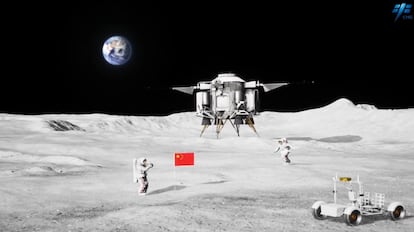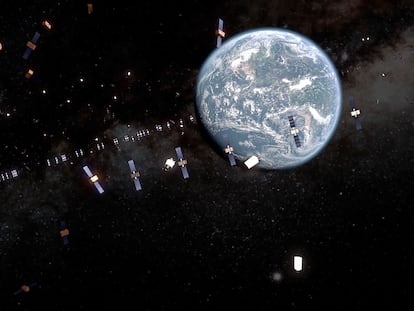China unveils plans to send ‘taikonauts’ to the moon from 2030 onward
The Asian superpower’s project, which combines elements of the 1960s manned mission programs, kicks off with a lunar satellite launch

The Chinese Space Agency has made its plans for a moon landing public. If everything works out as they hope, it will happen in the 2030s, although it is not clear when. At present, NASA expects to do so in September 2026, but the delays so far suggest that it will probably be postponed a bit longer. There is a possibility that, in the future, we will see a repeat of the 1960s space race between the United States and the USSR. In recent years, China placed three devices on the surface of the moon and last Wednesday they successfully launched the Queqiao-2 satellite as a spearhead to improve communication from Earth and support upcoming missions to the moon’s far side and south pole.
Half a century ago, the Soviet Union kept its plans a strict secret. In fact, after the Apollo 11 moon landing, the superpower officially denied that it had any intention of risking lives to go to the moon when identical results could be achieved by robots. And it is true that the USSR had spectacular success in this area. However, it was not until the Gorbachev era that models of what should have been Soviet lunar spacecraft began to appear here and there. Although the Kremlin had ordered the destruction of all traces of the program, some of the material survived long enough for historians to get an idea of what might have been but was not.
Today, China is pursuing a somewhat more transparent policy. It has not yet provided many details, but it has recently shown its names and models of lunar spacecraft: the main capsule, which will take three astronauts to the moon and bring them back, will be called Mengzhou (which means dream ship); the descent module that will go to the surface is called Lanyue (embrace the moon). These two names are very much a product of Chinese culture and follow the tradition of other vehicles, which were baptized as celestial palace and divine ship.
Half a century ago, the Soviets and Americans decided to use a single launcher to lift the manned module and the lunar lander simultaneously. That required monster rockets like the U.S. Saturn V or the USSR’s N-1. China does not currently have such powerful space shuttles, so it will send the two pieces separately. The rocket deployed will be a three-body model whose appearance is very reminiscent of SpaceX’s Falcon Heavy, the one that sent Elon Musk’s Tesla convertible into space on its maiden flight.
First, the lunar lander will be launched into orbit around the moon, where it will await the arrival of two astronauts (called “taikonauts” in Chinese). Once the initial maneuver is completed, with the Lanyue properly stationed (circling the moon), a second rocket will propel the Mengzhou with its three crew members from Earth into lunar orbit. There, it will tether with the descent vehicle similar to how the Apollo program did it. Two astronauts will go through an internal hatch, separate the two spacecraft and begin the lunar landing maneuver.
The new race to the moon: Similarities and differences from the past
The Chinese lunar lander is more inspired by the Russian system (which was never used) than by the American one. It will be mounted on a large rocket, which will do most of the stopping on the moon until it reaches a low altitude above the ground. It will detach there, leaving the Lanyue to descend the last few meters supported by its four twin engines.

The Chinese lunar lander has a two-person capacity; its landing gear consists of four legs with a cushioning system; the square exit hatch leads directly to a ladder attached to the front leg. These details are quite reminiscent of the Apollo Lunar Module; and its weight will be similar, perhaps slightly heavier on the Chinese vehicle. But that’s where the similarities end.
The Lanyue has only one set of engines; the U.S. Lunar Module had two independent engines, one for landing and one for re-ascent, each with its own control systems and fuel reserves. China seems to have adopted a solution identical to the one the Russians employed 60 years ago: a large, expendable rocket in mid-descent and comparatively weak engines for the final landing phase.
On the return to Earth, the same set of engines will be used for liftoff as for the descent, the same solution that the 1960s Russian lunar module had. To be on the safe side, that one had two reactors; the Lanyue will have four. The Apollo Lunar Module relied on a single reactor, different from the lander. However, its construction was so simple that, in theory, there was nothing that could fail. The four Lanyue engines develop a combined thrust of about 3 tons. In the moon’s reduced gravity, they could lift a payload of 15,000 kilograms (around 16.5 tons), about what the entire Apollo weighed (including the lower segment and legs).
The descent vehicle could be reusable
Unlike the Apollo program, it appears that the Chinese project could launch from the moon with the entire spacecraft, without needing to leave dead weight, such as the landing gear, on the ground. After returning to lunar orbit, it will dock with the main spacecraft where the third astronaut will be waiting to return home, leaving the lunar lander behind.
In the 20th century U.S. and Soviet programs, once the astronauts were in orbit, the lunar module was discarded by crashing it to the surface. Since its landing segment had been left on the ground, it was no longer of any use. But if the entire Chinese lunar module is parked again circling the moon, that raises the interesting possibility of refueling it and using it for a second expedition.
Flight Scheme of China Manned Lunar Exploration 🛰️👤🛸👥🌕 🇨🇳
— Future Spaces (@SpacesFuture) September 21, 2023
__
¹https://t.co/g9AybFvqML
²³⁴https://t.co/LEXJ78wk8O
¹🖼️²🖼️
³🖼️⁴🖼️ pic.twitter.com/NQre5HNJ1g
The Chinese space agency has not explained anything about this. An in-orbit refueling maneuver requires mastering two techniques: automatic encounter and the transfer of liquid from one spacecraft to another. In 2020, China demonstrated with its Chang’e 5 robot that it has solved the first challenge. Refueling is another issue; that is also a concern for Elon Musk and his Starship mega rocket, since it will be an essential operation of the Artemis 3 mission crew’s descent to the moon.
The Lanyue has two parts on the roof that resemble Mickey Mouse’s ears. They are folding photoelectric panels that resemble a Chinese fan. Powered by solar energy, it can stay on the moon for up to 15 days, much longer than the Apollo Lunar Module, which only had non-rechargeable batteries.
On the other hand, its apparent lack of windows is surprising, although the design may change. The Chinese space agency has announced that the Lanyue will be able to operate under manual control or automatically; but if there are taikonauts on board, it seems reasonable to allow them to see the panorama they are heading toward. The Apollo program always landed under manual control, but China has developed excellent automatic landing systems that have allowed it to land several times, not only on the moon, but also on Mars. Unlike other competitors, no Chinese probe has ever crashed on the moon.
The Chinese lunar spacecraft model also includes a four-wheeled vehicle, folded and attached to the outside of the cabin. For now, it is only a project, the development of which has been commissioned to a private company, much like NASA did when it contracted Boeing to build the electric aircraft used in the last three lunar expeditions.
The Chinese program’s objectives and weaknesses
On the other hand, some experts have pointed out certain weaknesses in the Chinese design. The main one is the danger of damaging the engines during landing, which would pose a very serious risk to the two astronauts. During the Apollo 15 mission, the lunar module’s nozzle was deformed when it hit the ground. The incident was not consequential because the engine was only used during descent, while the launch engine remained safely inside the cabin. But in the Chinese case, all the nozzles are unprotected and exposed to damage from impacts or ricochets of fragments carried by the exhaust gases.
Except for the announcement of its intention to reach the moon in the next decade, the Chinese agency has not published any flight programs. If the experience of 60 years ago is anything to go by, at least four test missions are to be expected, some unmanned and some limited to orbit. In any case, the final launch rocket will not be ready for about three years.
Moon landings can only be attempted when the vehicles have proven their reliability. They have already identified some 30 possible sites, including the Shackelton crater (near the South Pole) and even one on the far side of the moon (in the Mare Moscoviense), although given the difficulties involved, this will only be done much later. The first one will likely be in the equatorial zone, where there are wide plains that are relatively free of obstacles.
The program’s ultimate goal is not just to plant a national flag and return with a few pounds of rocks, but to establish a permanent base, probably near the south. The Chinese agency refers to it as the ILRS (International Lunar Research Station), although few countries have considered participating so far. In contrast, the Artemis agreements, a rival initiative sponsored by NASA to coordinate the future exploration of the moon, already has 35 signatory countries.
Sign up for our weekly newsletter to get more English-language news coverage from EL PAÍS USA Edition
Tu suscripción se está usando en otro dispositivo
¿Quieres añadir otro usuario a tu suscripción?
Si continúas leyendo en este dispositivo, no se podrá leer en el otro.
FlechaTu suscripción se está usando en otro dispositivo y solo puedes acceder a EL PAÍS desde un dispositivo a la vez.
Si quieres compartir tu cuenta, cambia tu suscripción a la modalidad Premium, así podrás añadir otro usuario. Cada uno accederá con su propia cuenta de email, lo que os permitirá personalizar vuestra experiencia en EL PAÍS.
¿Tienes una suscripción de empresa? Accede aquí para contratar más cuentas.
En el caso de no saber quién está usando tu cuenta, te recomendamos cambiar tu contraseña aquí.
Si decides continuar compartiendo tu cuenta, este mensaje se mostrará en tu dispositivo y en el de la otra persona que está usando tu cuenta de forma indefinida, afectando a tu experiencia de lectura. Puedes consultar aquí los términos y condiciones de la suscripción digital.
More information
Archived In
Últimas noticias
James Cameron: ‘For the films I like to make to continue to exist, we have to find a way to make them cheaper’
Families demand repatriation of bodies of Colombians who died in Ukraine: ‘This war is a slaughterhouse for foreigners’
Mexico’s missing people crisis casts a shadow over World Cup venue
ICE raids trigger school absenteeism and traumatize children: ‘They have been forced to leave their childhood behind’
Most viewed
- Christian Louboutin: ‘Young people don’t want to be like their parents. And if their parents wear sneakers, they’re going to look for something else’
- US sanctions against jailed cartel leader ‘El Marro’ highlight Mexico’s lack of control over its prisons
- Cartels in Mexico take a leap forward with narco-drones: ‘It is criminal groups that are leading the innovation race’
- Liset Menéndez de la Prida, neuroscientist: ‘It’s not normal to constantly seek pleasure; it’s important to be bored, to be calm’
- ‘El Limones’ and the growing union disguise of Mexican organized crime











































